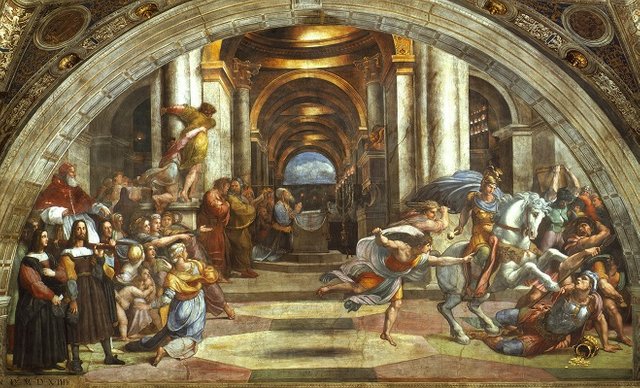Raphael Santi - Unusual gift unfolded in a short life

Raphael Sanzio to Urbino or Raphael Santi , but most simply to Rafaello, appears in the best time - the time when the Renaissance has an urgent need for artists to bring the ideals of humanism and beauty back into the world. Raphael was born on March 28, 1483. In fact, it is necessary to clarify that the date may be 26 March or 6 April. The confusion stems from the fact that Giorgio Vasari, the biographer of the great artists of that time, writes that Rafaello is on his 37th birthday on April 6, 1520. And he adds that he was born and died on Good Friday, which can not be true for both dates. In 1483 Good Friday falls on March 28, so most researchers accept that date. Rafaello was born in the family of artist Giovanni Santiti and his children passed to the hometown of Urbino. Between 1500-1504, according to Giorgio Vasari, he studied painting with another famous artist for his time - Pietro Perugino of Perugia. From this period, works are born that show the younger Rafaello's imprinting style. It is said that he managed to paint his teacher's style so well that his canvases were different from those of Perugino. From this period are canvases such as "The Three Graces" and "The Sleep of the Knight", as well as "St. George in the Dragon Fight".
In 1503, Rafaelo departed for Florence, where he met the works of the other great artists of the epoch - Leonardo da Vinci, Michelangelo and Donatello. At that time, and under the influence of the great geniuses of the brush, Rafaello's own style was formed. His paintings become more agile and his knowledge is enriched. He is friends with the monk-painter Fra Bartholomeo. In Florence, Rafaello is known for his Madonna and devotes himself entirely to them. In 1504, the first of his significant works - "The Worship of the Virgin" - appeared, showing his new ideas and compositional decisions. That same year he painted the "Grand Duke's Madonna," characterized by strict beauty, unlike the later soft and milky images. As a gift to a friend, a Florentine merchant creates the "Madonna with the Cigarette", where the Virgin is depicted with the baby and the little John, who gives Jesus a bird, a symbol of fertility. In this painting, Rafaello used the Leonardo da Vinci pyramidal composition. Among the other works of his Florentine period are "Portrait of Pietro Bembo", "Young woman with a unicorn", portrait of Angelo and Magdalena Donni, "Laying in the Grave" and "Complaining of Christ", Madonna Estherhazi and "Beautiful Gardener" .
In 1509, Rafaello received an order from Pope Julius II, commissioning him to design and write three of the Vatican Museums - Stanca della Signature, Stanca di Eleodoro and Stanca Zalia, later called Raffaello's Rooms. His most famous works are the frescoes in the Stanzas de la Signatura (the Hall of the Press, the place where all Papal documents are stamped) - the "Athens School" and "The Scripture Dispute". "The Athens School" is an example of the use of the linear and aerial perspective. In it, Raffaello depicts many of the great philosophers, poets and thinkers of antiquity - Aristotle, Plato, Pythagoras, Heraclitus and Ptolemy. Plato, with its look, reminds Leonardo da Vinci, Heraclitus - Michelangelo, and recent X-ray studies show that this figure was added later. Elucid / Bramante /, drawing geometric figures, and in the lower right corner where Ptolemy with the globe and Zarathustra are depicted with the heavenly sphere, the artist has made a self-portrait (painted as a young man with a red garment and a green hat). In Rome, Rafaello creates not only frescoes, but also many individual paintings. He draws a portrait of the beautiful daughter of a Trastevere baker - "Donna Velata". In 1513 he created one of his most famous works - the Sistine Madonna. The work gives the Madonna the radiance of a queen, despite her modest clothing, because it is placed in the encirclement of Pope Sixtus and St. Barbara. He draws many more pictures of religious and mystical stories. One of his latest works is "Transfiguration Christ", which is created by Julio di Mediano.
Raphael is also remarkable for his achievements as an architect. It creates one of the masterpieces of the Renaissance architecture - Madama Villa. The Pandolphin Palace in Florence is also a project of Rafaello. Giorgio Vasari does not detail the reasons for Raphael's death. The great brush maker is famous for his stormy lifestyle, especially when it comes to his "feats" on the sexual front. According to one version, the excess of sex is the cause of his sudden death. But on the other hand, it is known that the last 15 days of his life, Raphael hastened to put his order in his earthly affairs, dictated his will and received the last sacrament. Probably the cause of his death becomes ill-treated Roman fever.
Great post.
You got a 14.35% upvote from @postpromoter courtesy of @daydreaming!
Want to promote your posts too? Check out the Steem Bot Tracker website for more info. If you would like to support the development of @postpromoter and the bot tracker please vote for @yabapmatt for witness!
You have recieved a free upvote from minnowpond, Send 0.1 -> 10 SBD with your post url as the memo to recieve an upvote from up to 100 accounts!